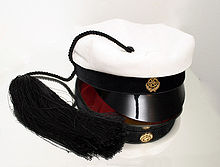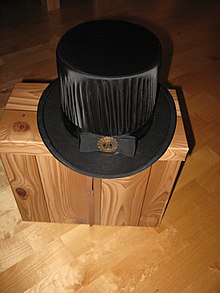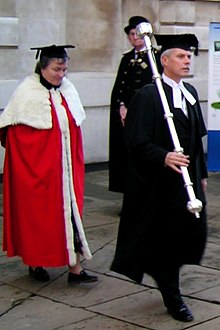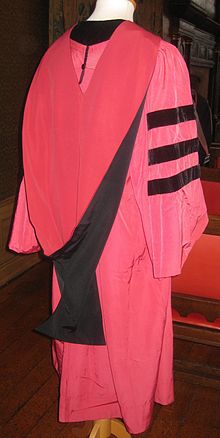Academic dress


Academic dress or academical dress is a traditional form of clothing for academic settings, primarily tertiary (and sometimes secondary) education, worn mainly by those that have been admitted to a university degree (or similar) or hold a status that entitles them to assume them (e.g., undergraduate students at certain old universities).[1] It is also known as academicals and, in the United States, as academic regalia.
Contemporarily, it is commonly seen only at graduation ceremonies, but formerly academic dress was, and to a lesser degree in many ancient universities still is, worn on a daily basis. Today the ensembles are distinctive in some way to each institution, and generally consists of a gown (also known as a robe) with a separate hood, and usually a cap (generally either a mortarboard, a tam, or a bonnet). Academic dress is also worn by members of certain learned societies and institutions as official dress.[2][3]
Overview
The academic dress found in most universities in the British Commonwealth and the United States is derived from that of the universities of Oxford and Cambridge, which was a development of academic and clerical dress common throughout the medieval universities of Europe.[4]
Formal or sober clothing is typically worn beneath the gown so, for example, men would often wear a dark suit with a white shirt and tie, or clerical clothing, military or civil uniform, or national dress, and women would wear equivalent attire. Some older universities, particularly Oxford and Cambridge, have a prescribed set of dress (known as subfusc) to be worn under the gown. Though some universities are relaxed about what people wear under their gowns, it is nevertheless considered bad form to be in casual wear or the like during graduation, and a number of universities may bar finishing students from joining the procession or the ceremony itself if not appropriately dressed[5] (though this sometimes refers only to requiring the proper wear of academic dress and not what is worn beneath it, if unseen).
Materials
In general, the materials used for academic dress are heavily influenced by the climate where the academic institution is located, or the climate where the graduate will usually be wearing the costume (as a faculty member at another institution, for example). In either case, the ACE allows for the comfort of the wearer, and concedes that lighter materials be used in tropical climates, and heavier materials elsewhere.[6] In addition, it acknowldges cotton poplin, broadcloth, rayon, or silk as appropriate.[7]
The materials used for academic dress varies and range from the extremely economical to the very expensive. In the United States, most Bachelor and Master degree candidates are often only presented the "souvenir" version of regalia by their institutions or authorized vendor, which are generally intended for very few wearings and are comparatively very inexpensive. For some doctoral graduates commencement will be the only time they wear academic regalia, and so they rent their gowns instead of buying them. These rented (or hired)[8] gowns are often made of inexpensive polyester or other man-made synthetic fibre. In Britain, rented gowns are almost always polyester whilst Russell cord, silk or artificial silk gowns are only available when bought. Undergraduate gowns are usually made from cotton or cotton and polyester mix and are relatively inexpensive to encourage students to own them.
People who choose to buy their dress may opt for finer fabrics, such as princetta, poplin, grosgrain, Percale, cotton, wool, cassimere, broadcloth, bengaline, Russell cord or corded/ribbed material. For silk, there are a range of types including artificial silk/rayon, ottoman (i.e. ribbed or corded silk), taffeta, satin, alpaca, true silk, shot silk or a mixture. Pure ottoman silk is rarely used except for official gowns as it is very expensive.[9] Some gowns may be trimmed with gimp lace, cords, buttons or other forms of decoration.
In the past, fur has been used to line certain hoods (especially those of the UK) which range from rabbit to ermine. In the past, sheepskin was widely used. Most now use imitation fur instead, mainly because of cost and animal rights concerns. Some robemakers will use fur if the customer requests and pays for it, as some feel that the quality and feel of artificial fur has yet to match that of real fur.[10]
Doctor's robes usually use wool flannel, Panama, damask or brocade and are brightly coloured (or black, but faced with a bright colour) to distinguish them from lower degrees. They tend to be the most expensive because they must be dyed in a specific colour and/or be trimmed in coloured silks. Many doctoral gowns have a special undress version so adding to the cost of a full set.
A full set may cost about $360 (£180) for cheap materials to as much as $5800 (£2900) for high quality materials.[11] Usually, ex-hire gowns are available for purchase at cheaper prices though the quality may be lower.[12]
Academic dress by country
China
This section needs expansion. You can help by adding to it. (November 2008) |
France
This article is partially translated from http://fr.wikipedia.org/wiki/Robe_universitaire
In France, academic dress, also called the toge (from the word toga, an ancient Roman garment), is similar to French judges' court dress, except for its colour, which depends on the academic field in which the wearer graduated. It is nowadays little worn, except by doctors during the opening of the university year or the ceremony for a doctorate honoris causa. For doctors, it consists of:
- a long gown (a bit similar to a cassock) with a long row of buttons (traditionally, 33, but nowadays usually fewer) in front and a train at the back (which in the current costume is not visible but attached with a button in the inner side of the gown). The gown is in two colours: black and the standard colour of the academic field in which the wearer graduated (see below), with simarras (two vertical bands in the front of the gown).
- an épitoge (epitoga): a piece of cloth with white fur stripes (three for doctors) attached by a button on the left shoulder, with a rectangular ,long, thin tail in the front and a triangular, shorter, broad tail in the back (both tails carry the fur stripes); its colour is that of the relevant academic field. The epitoga has evolved from the academic hood, which explains why the French academic dress does not include a hood.
- a long, wide belt or sash, either black or of the colour of the relevant academic field, ended by fringes (which may be golded or of the same colour as the belt), and attached with a broad ornamental knot.
- a white rabat (jabot), over which a white tie may be worn for ceremonial occasions. Il is made of lace for the Dean of the Faculty, the President of the University, and a few other officials; of plain cotton for others.
- only for men, a mortarboard of the colour of the relevant academic field with a golden stripe, which is usually not worn but carried (since anyway the academic dress in France is rarely worn outdoors, and men are supposed not to wear hats indoors), and often even omitted.
- in principle white bow tie and white gloves.
Professors who served 20 years are sometimes presented with a sword (identical model to that of French Police commissars).
The colours of the various academic fields are daffodil (yellow) for literature and arts, amaranth (purplish red) for science, redcurrant (reddish pink) for medicine, scarlet red for law, and violet (purple) for theology. University rectors, chancellors or presidents wear also specific costumes, which are violet regardless of the academic field in which they graduated.
| Field of graduation | Colour name | Colour aspect |
|---|---|---|
| Divinity (and all high officials regardless of the field) | Violet (Purple, specifically the Royal Purple shade) | |
| Law (colour also worn by high magistrates) | Écarlate (Scarlet) | |
| Medicine (and health-related fields) | Groseille (Redcurrant, a reddish shade of pink) | |
| Science (exact and experimental) | Amaranthe (Amaranth) | |
| Arts, literature, philosophy, humanities | Jonquille (Daffodil, a shade of yellow) |
The dress exists in two versions: the petit costume ("small costume") and the grand costume ("great costume"). Both are identical in form, and differ only in the presence or absence of the mortarboard and the repartition of colours on the gown and sash (the other elements of the dress, especially the epitoga, being identical for both):
- for the petit costume, the gown is all black, except the simarras which are of the colour of the academic field; the buttons are black; the sash and its fringes moiré black; the mortarboard is usually not worn;
- for the grand costume, the gown is black between the simarras, which are moiré black, and of the colour of the academic field on the sides and on the sleeves, except their turn-ups, which are black; the buttons are of the colour of the academic field; the sash is of the colour of the academic field, its fringes may be either the same colour or gold.
In formal occasions, the grand costume is equivalent to white tie, whereas the petit costume is equivalent to black tie.
Germany
This section is based on http://de.wikipedia.org/wiki/Talar

The German academic dress is called "Talar" (with the accent on the second "a": talár; from Latin talare which means to the ankles), and can be described as the normal black long gown with wide sleeves common to all scholars in Europe and America. It can be traced back to the every day clothes of the scholars in the Middle Ages. The same word Talar is also used for the robes of Protestant (Lutheran) pastors, judges, and rabbis, although these gowns often differ more or less in cut, length, drappings, and sometimes even in color (the gowns of the German Supreme Court are, e.g., completely dark red).
In Germany only the rectors, deans, professors, and lecturers wore the gowns—not students or graduates. Each German university had its own system of colors and drapings, which differs from that of British and American universities (for example, theology is normally not bright red but dark purple, similar to the French system). After the so-called "student's revolution" following the years of 1967, all German universities dropped their academic dress because they were identified with right-winged conservatism and reactionism by the mostly socialist influenced students at that time: The famous slogan "Unter den Talaren - Muff von 1000 Jahren" (beneath the gowns the fug of 1000 years) refers not only to the old traditions of the Middle Ages, but also to the Nazi regime and their self-declared "empire of 1000 years".[13]
It was not until recently that some universities started to use their traditional academic dress again. For example, the University of Bonn re-adopted academic dress in 2005 for the first time since 1969.[14] Today many young and newly founded universities also use academic dress, not to revive old traditions but to follow Anglo-American examples.
New Zealand
University graduates in New Zealand wear an academic gown identical to those of the University of Cambridge[15] and either a hood or scarf, depending on whether the graduate is receiving a degree or diploma. If the graduate is receiving a degree, a hood[15] will be worn throughout the ceremony. If a diploma is received, the graduate will wear a diploma scarf.[16]
The hood, like the gown, is identical to that of the hood for the Cambridge Master of Arts. A Bachelors degree is lined with coloured satin and bordered with white fur. The master's degree hood has no fur. A Doctoral Degree recipient wears the same as a graduate receiving a Masters, except the gown is completely silk, either black or scarlet, with the option to wear a cloth gown. A Doctoral hood is completely silk.
Below is a list of the general hood colours of graduates:
| Faculty | Colour | Sample |
|---|---|---|
| Architecture | Lemon | |
| Arts | Pink | |
| BBIM | Apricot (colour) | |
| Business Administration, MBA | Burgundy | |
| Commerce | Orange | |
| Dentistry | Violet | |
| Economics | Copper | |
| Education | Emerald,[15] Coral (colour)[17] | |
| Engineering | Dark Violet | |
| Fine Arts, | Gold (colour) | |
| Human Biology | Crimson | |
| Law | Light Blue | |
| Medicine | Lilac (colour) | |
| Music | White | |
| Nursing | Navy (colour) | |
| Optometry | Blue Green | |
| Performing Arts | Pink | |
| Pharmacy | Grey Green | |
| Philosophy | Dark Blue | |
| Physical Education | Sage Green | |
| Planning | Green | |
| Property | Silver (colour) Grey | |
| Science | Dark Blue | |
| Theology, Divinity | Forest Green, Violet Grey |
Philippines


Most universities in the Philippines prescribe the traditional cap, hood and gown in graduation. In the known schools of the country, the color of the attire corresponds to the school color (Blue for Ateneo de Manila University, Green for De La Salle University and Far Eastern University, and Red for San Beda College). Also, some schools like the University of Santo Tomas still follow the Spanish Academic attire such as the wearing of academic biretta and mozetta. A unique graduation garb is by the University of the Philippines is the use of the Sablay. The Sablay was inspired from the malong of Muslim Mindanao thus, giving it a Filipiniana look. It features the indigenous baybayin characters for "U" and "P".[18] During the commencement ceremony, graduates wear the sablay at the right shoulder, it is then moved to the left shoulder after the President of the University confers their degree, "similar to the moving of the tassel of the academic cap." The Sablay is worn over traditional Filipino costume - usually a Barong Tagalog men and Filipiniana dress for women.
Portugal
In most Portuguese universities and other types of higher education institutions, usage of academic dress for undergraduates, or traje académico is still widespread and has even gained popularity in recent decades.[citation needed] The traje is composed of black trousers (or skirt, for female students), white shirt, black tie, a black overcoat, known as batina (in the case of male students, the classical traje also includes a black vest) and a black robe.[19] Some Portuguese higher education institutions have their typical academic outfit which differs greatly from that born in the ancient University of Coimbra. This is the case, for example, of those worn by the students of the University of the Algarve and Minho University. Usage is generally restricted to the first weeks of the semester, during the introductory and reception activities which make part of the Praxe tradition. In some older institutions, where traditions are better implemented, one can see students trajados during the entire year, though.
Singapore
 |
 |
Spain
This article is partially translated from http://es.wikipedia.org/wiki/Indumentaria_académica


The typical Spanish academic dress has Latin origin. It has been regulated since 1850, when Queen Isabella II established several rules about academic dress, according to the centuries-old Spanish custom. The typical Spanish academic dress for doctors is composed by:
- A black long gown (toga) with a long row of buttons, made of satin and wool. It is worn over a black suit.
- A mozzetta (muceta), whose colour depends on the academic field.
- Long embroidered cuffs (puñetas). They are usually made of white cotton, although those of the Rector (University president) are red or pink. The buttons are made of gold for the Rector and made of silver for the Deans.
- A round biretta (birrete), whose colour depends on the academic field.
- White gloves.
- A ring is usually worn by doctors.
- A staff or scepter (bastón) made of American reed is worn by the University rector.
- Medallions are often worn by postgraduates, doctors, professors, deans and the University rector.
However, this academic dress is only used for the opening of the academic year and for PhD graduations or for doctorates honoris causa. It is worn only by doctors, deans and the University Rector. For other graduates, the academic dress is often composed by a mortarboard and a mozzetta (muceta) or a sash over the shoulder (beca) with the shield of the University and/or Faculty. The colour of the mozzetta or the sash depends on the academic field.
The colours used in Spain for the various academic fields are:
Sweden and Finland


Finland and Sweden have similar traditions when it comes to academic dressing. For finer academic situations white tie is usually worn, however, often together with special headwear or even a cape.
In Finland and Sweden students of technology wear a special kind of cap called a teekkarilakki (Finnish) or teknologmössa (Swedish). It is similar to the cap given to all high-school graduates in both countries, but features a tuft and different kind of cockade showing what university the bearer is attending. Technology students generally wear their caps much more frequently, and thus the tuft often symbolizes university-engineers. Although different universities have different etiquettes regarding the use of the cap, it is generally not awarded to the student before he or she has completed the first year of studies. The technology student's hat may also be worn in quite informal occasions, such as together with the "party overalls" worn as part of the student culture at many universities.
In both countries also many universities have doctoral hats for persons who have completed a Ph.D. or similar degree, these are usually top hats. At some universities, a doctoral ring is awarded together with the hat. In the Ingmar Bergman film, Wild Strawberries, in one scene is the conferral of a Jubilee doctor degree on the main character at the University of Lund, which includes the presentation of such a hat and ring. At the University of Helsinki wearing a cape and a sword together with the doctoral hat is common. Students of the student organization "Limes" are also often seen wearing a black cape.[20]
Tunisia
University of Ez-Zitouna(Established 737) graduates in Tunisia wear an academic gown identical to those of the University of Ez-Zitouna, Ph.D. in Islamic Sciences wear a Jebba .

United Kingdom



There is a distinction between different types of academical dress. Most recently, gowns, hoods and caps are categorised into their shape and patterns by the Groves classification system, which is based on Nicholas Groves's document, Hood and Gown Patterns.[21] This lists the various styles or patterns of academic dress and assigns them a code or a Groves Classification Number. For example, the Cambridge BA style gown is designated [b2] and a hood in the Cambridge full-shape is designated [f1], etc. Because the universities are free to design their own academicals using a wide range of available gown, hood and cap patterns, colours and materials at their and the robemaker's disposal, the academicals of two given universities rarely clash with each other.
The Burgon Society was founded in 2000 to promote the study of academic dress.[22] It has publications and activities to do with academic dress and is currently in the process of updating Shaw's book on British and Irish academical dress for publication.[23]
The modern gown is derived from the roba worn under the cappa clausa, a garment resembling a long black cape. In early medieval times, all students at the universities were in at least minor orders, and were required to wear the cappa or other clerical dress, and restricted to clothes of black or other dark colour. The gowns most commonly worn, that of the clerical type gowns of Bachelor of Arts (BA) and Master of Arts (MA), are substantially the same throughout the English-speaking world. Both are traditionally made of black cloth, (although occasionally the gown is dyed in one of the university's colours) and have the material at the back of the gown gathered into a yoke. The BA gown has bell-shaped sleeves, while the MA gown has long sleeves closed at the end, with the arm passing through a slit above the elbow.[24] In the Commonwealth, gowns are worn open, while in the United States it has become common for gowns to close at the front, as did the original roba.
There are two distinctive shapes used in the UK for doctor's gown; the Oxford doctor's shape and the Cambridge doctor's shape. The former has bell-shaped sleeves, the latter has long open sleeves. Another rarer form is the Cambridge MusD dress gown which is a pattern between the two. The other form of doctor's gown is the undress gown. This is a black gown worn for less formal occasions such as lectures. This type of gown is rarely seen or worn nowadays as many wear the dress gown instead; however, the undress gown still plays a part in the older universities where academic dress is usually worn.
Undergraduates at many older universities also wear gowns;[25] the most common essentially a smaller knee-length version of the BA gown, or the Oxford Commoners gown which is sleeveless lay type gown and has two streamers at the back at Oxford.[26] At Cambridge, most colleges have their own distinctive design of gown.[27] Undergraduate gowns are seldom worn (even in institutions that prescribe them) nowadays except in the older universities.
Another form of dress, now rarely seen, is the habit, which is worn over a black gown. Only Oxford and Cambridge (though in theory Durham too) use habits and mainly reserve their use for very formal ceremonial occasions and to a specific group of academics or officials.
The hood was originally a functional garment, worn to shield the head from the elements. In the English tradition, it has developed to an often bright and decorative garment worn only on special occasions. Hoods comprise two basic patterns: full shape or simple shape. The traditional full-shape hood consists of a cape, cowl, and liripipe, as is used at Cambridge. At Oxford, the bachelors' and masters' hoods use simple hoods that have lost their cape and retain only the cowl and liripipe.[28] The colour and lining of hoods in academic dress represents the rank and/or faculty of the wearer.[29] In many Commonwealth universities bachelors wear hoods edged or lined with white rabbit fur, while masters wear hoods lined with coloured silk (originally ermine or other expensive fur). Doctors' hoods are normally made of scarlet cloth and lined with coloured silk.[30] Faculty colours were introduced by the University of London and many universities followed suit.[31]
The academic cap or square, commonly known as the mortarboard, has come to be symbolic of academia. In some universities it can be worn by graduates and undergraduates alike. It is a flat square hat with a tassel suspended from a button in the top center of the board. The mortarboard may also be referred to as a trencher cap (or simply trencher). The tassel comprises a cluster of silk threads which are fixed together and fastened by a button at one end, and fixed at the centre of the headpiece. The loose strands are allowed to fall freely over the board edge, typically falling over the left front side of the cap. Often the strands are plaited together to form a cord with the end threads left untied. In many universities, holders of doctorates wear a soft rounded headpiece known as a Tudor bonnet or tam, rather than a trencher. Other types of hats used, especially in some universities in the UK, are the John Knox cap (mostly at Scottish universities), the Bishop Andrewes cap (a reinvention of the ancient form of the mortarboard, worn by Cambridge DDs) and the pileus (at Sussex). In some universities, such as Oxford, women may wear an Oxford ladies' cap.[32]
Officers of the universities generally wear distinctive and more elaborate dress. The Chancellor and the Vice-Chancellor may wear a black damask lay type gown (sometimes with a long train) trimmed with gold or silver lace and frogs. They wear a velvet mortarboard, similarly trimmed with gold braid and tassel. Other than this gown, they may have other distinct forms of dress, such as the scarlet cappa clausa or cope worn in certain circumstances by the Vice-Chancellor of Cambridge or his/her deputy and by higher doctors presenting candidates for degrees, which was once worn by Doctors of Divinity.[33] In the past, Chancellors may also wear full court dress with breeches and court shoes like that of the Lord Chancellor of Great Britain.
At degree ceremonies, graduands often dress in the academic dress of the degree they are about to be admitted to prior to the actual graduation ceremony. This is not the case at several of the older universities in the UK, most notably, Oxford, Cambridge and St Andrews which have their own distinct traditions.
United States



Academic regalia in the United States has been influenced by the academic dress traditions of Europe. There is an Inter-Collegiate code which sets out a detailed uniform scheme of academic regalia followed by most, though some institutions do not adhere to it entirely, and fewer still ignore it.
The practice of wearing academic regalia in what is now the United States dates to the Colonial Colleges period, and was heavily influenced by European practices and styles.[34] Students of most colonial colleges were required to wear the "college habit" at most times - a practice that lasted until the eve of the American Civil War in many institutions of higher learning.[35] In some rare instances the practice has persisted, such as at Sewanee, where members of one student society continue to wear the gown to class.[36] After the Civil War, academic regalia was generally only worn at ceremonies or when representing the institution.[35] There was not, however, any standardization among the meanings behind the various costumes. In 1893, an Intercollegiate Commission made up of representatives from leading institutions was created, to establish an acceptable system of academic dress. The Commission met at Columbia College (now Columbia University) in 1895 and adopted a code of academic regalia, which prescribed the cut and style and materials of the gowns, as well as determined the colors which were to represent the different fields of learning.[37] In 1932 the American Council on Education (ACE) authorized the appointment of a committee "to determine whether revision and completion of the academic code adopted by the conference of the colleges and universities in 1895 is desirable at this time, and, if so, to draft a revised code and present a plan for submitting the code to the consideration of the institutional members of the Council." The committee reviewed the situation and approved a code for academic costumes that has been in effect since that year. A Committee on Academic Costumes and Ceremonies, appointed by the American Council on Education in 1959, again reviewed the academic dress code and made several changes.[34]
Although academic dress is now rarely worn outside commencement ceremonies or other academic rituals such as encaenia in the U.S. graduation ceremonies have gained popularity and have expanded from high school graduations to middle school, elementary school and kindergarten graduation ceremonies.[38]
Bachelors' and masters' gowns in the United States are similar to their counterparts in the United Kingdom, though bachelor's gowns are now designed to be worn closed, and all are at least mid-calf length to ankle-length.[39] The masters' gown sleeve is oblong and, though the base of the sleeve hangs down in the typical manner, it is square cut at the rear part of the oblong shape. The front part has an arc cut away, and there is a slit for the wrist opening, but the rest of the arc is closed. The shape is evocative of the square-cut liripipe incorporated into many academic hoods (see, below). The master's gown is designed to be worn open or closed.[39]
Doctoral robes are typically black, although some schools use robes in the school's colors.[39] The Code calls for the outside shell of the hood (see, below) to remain black in that case, however. In general, doctoral gowns are similar to the gowns worn by bachelor's graduates, with the addition of three velvet bands on the sleeves and velvet facing running down the front of the gown. The Code calls for the gown trim to be either black or the color designated for the field of study in which the doctorate was earned (see Inter-Collegiate colors, below). However, it should be noted that in the case of the degree of Doctor of Philosophy (Ph.D.), although it is awarded for study in any number of fields, the dark blue velvet of philosophy is always used regardless of the particular field studied. For example, if not choosing black trim, a Ph.D. in theology would wear velvet gown trim in dark blue, while a Doctor of Theology (Th.D.) would wear scarlet trim, if not choosing black. The robes have full sleeves, instead of the bell sleeves of the bachelor's gown. Some gowns expose a necktie or cravat when closed, while others take an almost cape-like form. It is designed to be worn open or closed in the front.[39]
The Code calls for the shell material of the hood to match the robe, and for the color to be black regardless of the color of the robe being worn.[40] The interior lining - generally silk - displays the colors of the institution from which the wearer received the degree, in a pattern prescribed by it (usually, if more than one color is used, chevrons or equal divisions).[41] The opening of the hood is trimmed in velvet or velveteen.[42] In most American colleges and universities, the color of the velvet hood trimming is distinctive of the academic field — or as closely related as possible — to which the degree earned pertains (see Inter-Collegiate colors, below).[43] Many institutions, particularly larger ones, have dispensed with the bachelor's hood at commencement ceremonies altogether, though a graduate is still entitled to wear one once the degree is conferred.[44]
Headwear is an important component of cap-and-gown, and the academic costume is not complete without it. The headwear will vary with the level of academic achievement and, to some extent, on the individual academic institution's specifications. For caps, the mortarboard is recommended in the Code, and the material required to match the gown.[45] The exception—velvet—is reserved for the doctor's degree only, seen in the form of a multiple-sided (4, 6, or 8) tam, but the four-sided mortarboard-shaped tam in velvet is what the Code seems to recommend here.[45] The only color called for is black, in all cases.[45] The tassel worn on the mortarboard or a tam seems to provide, by tradition, the greatest opportunity for latitude in American academic dress. It has been black, or represented the university's colors, or the colors of the specific college, or the discipline. The tassel has also been used to indicate membership in national honor societies or other awards. There is at some colleges and universities a practice of moving the tassel from one side to the other on graduating, but this is a modern innovation that would be impractical out of doors due to the vagaries of the wind. For doctoral and masters students, the tassel commonly begins and remains on the left.[46]
The colors allocated to the various fields of learning have been largely standardized in the United States by the Intercollegiate Bureau of Academic Costume, and accepted by the American Council on Education in its Academic Costume Code.[41] Some of the more common colors seen are that liberal arts is represented by white, science by golden yellow, medicine by green, law by purple, and philosophy (including all Ph.D. degrees) by dark blue. A distinction is made in the code, which calls for a graduate to display the color of the subject of the degree obtained, not the degree itself.[42] For example, if a graduate is awarded a Bachelor of Arts (BA) degree specifically in business the trimming should be drab, representing commerce/accountancy/business, rather than white, representing the broader arts/letters/humanities; the same method is true of master's degrees and doctorates. However, in 1986, the American Council on Education updated the Code and added the following sentence clarifying the use of the color dark blue for the Doctor of Philosophy degree, which is awarded in any number of fields: "In the case of the Doctor of Philosophy (Ph.D.) degree, the dark blue color is used to represent the mastery of the discipline of learning and scholarship in any field that is attested to by the awarding of the degree, and it is not intended to represent the field of philosophy."[42]
A number of other items such as cords, stoles, aiguillettes, etc. representing various academic achievements or other honors are also worn at the discretion of some degree-granting institutions. Technically, however, the ACE code does not allow their use on or over academic regalia.
See also
- Academic procession
- Encaenia
- Academic stole
- Chinese academic dress
- Ede and Ravenscroft
- Graduation
- Burgon Society
- The Central Institute London
Academic dress details for the following universities are available via these links:-
United Kingdom and Ireland
- Academic dress of the University of Bristol
- Academic dress of the University of Cambridge
- Academic dress of Durham University
- Academic dress of the University of Edinburgh
- Academic dress of the University of Exeter
- Academic dress of the University of Hertfordshire
- Academic dress of Imperial College London
- Academic dress of the University of Kent
- Academic dress of the University of Leeds
- Academic dress of the University of London
- Academic dress of the University of Manchester
- Academic dress of the University of Nottingham
- Academic dress of the University of Oxford
- Academic dress of the University of St Andrews
- Academic dress of the University of Wales
- Academic dress of the University of Wales, Lampeter
- Academic dress of the University of Warwick
Others
- Academic dress of La Trobe University
- Academic dress of the Royal Melbourne Institute of Technology
- Academic dress of Harvard University
- Academic dress of universities in Queensland, Australia
- Academic dress of University of Melbourne
Bibliography
Books
- Fowler, J. T. (1904), Durham University: earlier foundations and present colleges. London: F. E. Robinson & Co.
- Goff, Philip (1999), University of London Academic Dress. London: University of London Press. ISBN 0-7187-1608-6
- Shaw, George W. (1966, 1995), Academical Dress of British and Irish Universities. Chichlester: Philmore & Co. Ltd. ISBN 0-85033-974-X
- Groves, Nicholas (2002, 2003, 2008), Key to the Identification of Academic Hoods of the British Isles. London: Burgon Society.
- Groves, Nicholas; Kersey, John (2002), Academical Dress of Music Colleges and Societies of Musicians in the United Kingdom. Norfolk: Burgon Society. ISBN 0-9544110-0-5
- Hargreaves-Mawdsley, W.N. (1963), A History of Academical Dress in Europe. Oxford: Clarendon Press.
- Venables, D.R. & Clifford, R.E. (2009), 9th ed., Academic Dress of the University of Oxford. Oxford: Shepherd & Woodward. ISBN 0-9521630-0-4
Journals
- Kerr, Alex (ed.) et al. (2004), The Burgon Society Annual 2003.
- Kerr, Alex (ed.) et al. (2005), The Burgon Society Annual 2004. ISBN 0-9544110-6-4
- Kerr, Alex (ed.) et al. (2006), Transactions of the Burgon Society: Volume 5. ISBN 0-9544110-7-2
- Kerr, Alex (ed.) et al. (2008), Transactions of the Burgon Society: Volume 6. ISBN 0-9544110-8-0
- Kerr, Alex (ed.) et al. (2008), Transactions of the Burgon Society: Volume 7. ISBN 0-9789544-1105-3
- Kerr, Alex (ed.) et al. (2009), Transactions of the Burgon Society: Volume 8. ISBN 978-0-9561272-1-1
- Powell, Michael (ed.) et al. (2002), The Burgon Society Annual 2001.
- Powell, Michael (ed.) et al. (2003), The Burgon Society Annual 2002.
Electronic
- Sullivan, Eugene (ed.) An Academic Costume Code and An Academic Ceremony Guide, American Council on Education. Reprinted with permission from American Universities and Colleges, 15th Edition (1997). Walter de Gruyter, Inc.
- Smagorinsky, Margaret. The REGALIA of Princeton University: Pomp, Circumstance, and Accountrements of Academia. The Trustees of Princeton University (Printed by Office of Printing and Mailing), 1994. Accessed 09/26/2008.
Further reading
- American Council on Education staff (1997). American Universities and Colleges, 15th Edition. Walter de Gruyter, Inc. ISBN 0-275-98745-0
- Belting, Natalia Maree (1956), The History of Caps and Gowns, New York : Collegiate Cap & Gown Co. via Internet Archive
- Franklyn, C.A.H. (1970), Academical Dress from the Middle Ages to the Present Day Including Lambeth Degrees. Lewes: WE Baxter.
- Haycraft, F.W. (1948), 4th ed. rev. Stringer, E.W Scobie, The Degrees and Hoods of the World's Universities and Colleges. Cheshunt Press.
- Rashdall, H. (1895, 1936), The Universities of Europe in the Middle Ages. Oxford: Claredon Press.
- Rogers, F.R.S., Franklyn, C.A.H., Shaw, G.W., Boyd, H.A. (1972), The Degrees and Hoods of the World's Universities and Colleges. Lewes: WE Baxter.
- Smith, H.H., Sheard, K. (1970), Academic Dress and Insignia of the World. Cape Town: AA Balkema.
- Wood, T.W. (1882), The Degrees, Gowns and Hoods of the British, Colonial, Indian and American Universities and Colleges. London: Thomas Pratt & Sons.
References
- ^ Shaw (1995), p. 3
- ^ e.g. Burgon Society: Robes
- ^ "History and Archives of the American College of Surgeons; Highlight of the Month October 10, 2005; The Clinical Congress: Then and Now, accessed 01/29/2008". Facs.org. Retrieved 2010-04-28.
- ^ "Goff, pp. 13-14". Phildress.co.uk. Retrieved 2010-04-28.
- ^ n.wood@sheffield.ac.uk. "University of Sheffield: What should I wear?". Shef.ac.uk. Retrieved 2010-04-28.
- ^ Sullivan. The Academic Costume Code, Gowns, Material
- ^ Sullivan. The Academic Costume Code, Caps, Material
- ^ American English uses 'rented', British English uses 'hired'.
- ^ An Ede & Ravenscroft Oxford MA hood made of pure Ottoman silk will cost around £347. Source: http://www.gownhire.co.uk (21 September 2007)
- ^ The cost difference between artificial and real fur can be as much as a few hundred pounds.
- ^ Ede & Ravenscroft: Oxford DMus undress and full dress academic dress costs £2910 (undress gown: £181, hood: £409, rigid mortarboard: £80, full dress gown: £2117, velvet bonnet: £123). Information retrieved 18 May 2007.
- ^ Hired hoods are usually partially lined instead of fully lined when the regulations specify a fully lined hood. However, there are some cases where a hood that is specified as fully lined in the regulations, in practice, is part-lined to save on materials. This is especially the case for Glasgow full-shape hoods [f9] as they are large and most of the lining may not be seen when worn.
- ^ "Famous photo of students in 1967 revolting in Hamburg in front of fully dressed scholars". Spiegel.de. 2005-07-13. Retrieved 2010-04-28.
- ^ "2005: First use of gowns in Bonn since 1969". Spiegel.de. 2005-07-13. Retrieved 2010-04-28.
- ^ a b c http://www.auckland.ac.nz/uoa/cs-what-to-wear-to-graduation#s2c4
- ^ http://www.auckland.ac.nz/uoa/cs-what-to-wear-to-graduation#s2c5
- ^ http://www.alumni.otago.ac.nz/Page.aspx?pid=314
- ^ "UP Sablay". Retrieved 2010-08-21.
- ^ "El traje académico. Composición. Partes. Colores y titulaciones. Facultades. July 17, 2008 (accessed)" (in Template:Es icon). Protocolo.org. 2009-12-21. Retrieved 2010-04-28.
{{cite web}}: CS1 maint: unrecognized language (link) - ^ "Tiedostot | Viralliset asiat". Limes.fi. Retrieved 2010-04-28.
- ^ The Burgon Society: The Design of Academical Dress (6th May 2007) Classification of Styles
- ^ Burgon Society: Introduction (02 Nov 2008)
- ^ Burgon Notes, Autumn 2008.
- ^ Shaw (1995); pp. 4-7
- ^ Hargreaves-Mawdsley, pp. 91-101, 128-135, 146, 148-149
- ^ "Shepherd & Woodward: Oxford University student gowns". Shepherdandwoodward.co.uk. Retrieved 2010-04-28.
- ^ "CU Cap & Gown Society: Gown-spotter's guide". Srcf.ucam.org. Retrieved 2010-04-28. [dead link]
- ^ Burgon Annual 2003 (2004); pp. 18–23
- ^ Groves (2008), Hood Key
- ^ Shaw (1995); p. 8
- ^ Burgon Transactions vol. 5 (2006); pp. 80-89
- ^ Goff; pp.22-23
- ^ Shaw (1966); pp. 94-95
- ^ a b Sullivan. The Academic Costume Code, Historical Overview
- ^ a b Smagorinsky. The REGALIA of Princeton University: Pomp, Circumstance, and Accountrements of Academia. Page 5.
- ^ "About - The Order of Gownsmen - Sewanee :: The University of the South". Sewanee.edu. Retrieved 2010-04-28.
- ^ New York Times. "Gowns for College Men; Academic Costumes in American Universities (1896): Plan to Secure a Uniform Practice in the Use of the Caps and Gowns in This Country So that the Degree of the Wearer, the Faculty Under Whom It Was Obtained, and the Institution Conferring It May Be Readily Seen." Sunday, April 26, 1896.
- ^ "Kindergarten graduation in the United States". Rhymeuniversity.com. Retrieved 2010-04-28.
- ^ a b c d Sullivan. The Academic Costume Code, Gowns
- ^ Sullivan. The Academic Costume Code, Hoods
- ^ a b Sullivan. The Academic Costume Code, Hoods;Linings
- ^ a b c Sullivan. The Academic Costume Code, Hoods;Trimmings Cite error: The named reference "SullivanTrimmingsHoods" was defined multiple times with different content (see the help page).
- ^ Sullivan. The Academic Costume Code, Additional Guidance on Costume
- ^ Sullivan. The Academic Costume Code, Some Permissible Exceptions
- ^ a b c Sullivan. The Academic Costume Code, Caps
- ^ Sullivan. The Academic Costume Code, Wearing the Costume
External links
- The Burgon Society Promotes the interest in and the formal study of academic dress.
- The New York Times Article about the history of academic dress.
- University of London Academic Dress Publication concerning University of London academic dress.
- Ede & Ravenscroft Biggest and oldest robemaker in the UK.
- Academic Apparel Variety of articles on regalia history, wearing regalia, and commencement ceremonies.
- Cambridge University Cap & Gown Society Promotes gown and cap wearing at Cambridge University including history
- American Council on Education The authority on academic regalia in the United States.
- Klerikale Kopfbedeckungen Pictures, information and literature of some academical caps, especially academical birettas (in German)
- Decoding Graduation Caps & Gowns Video explores the meaning and mystery behind graduation attire.
- Articles about regalia and proper wear


